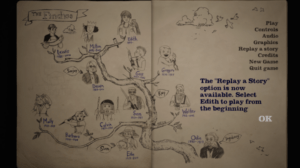Game Information
Name: What Remains of Edith Finch
Creator: Giant Sparrow, published by Annapurna Interactive
Platform: PlayStation, Xbox, Switch, IOS, and PC
Target Audience: Ages 10+
Naturally, walking simulators prioritize exploration, narrative, and atmosphere over more traditional elements like combat or strategy, making for a more immersive gameplay experience. Prioritizing these elements makes for a deeper exploration of a game’s narrative and it allows players to create personal connections to characters or the game itself. What Remains of Edith Finch stands an excellent case study for narrative storytelling through the action of walking. In this game, we control Edith as she explores an abandoned family home, walking through a disjoint storyline as we uncover the reality of what happened to generations of the Finch family. The game’s environment is decorated with memorabilia left by each member of the family and we gain insights into their stories when we interact with them. Only by visiting each room of the house can we access the backstories of family members, tasked with finding clues as to how to reach the next story. Unlike traditional games, players in WROEF have to navigate the environment through physical interactions: opening windows, crawling through secret entrances, jumping on trees, climbing into crawl spaces and more.
Central Argument: How Walking Tells the Story in WROEF
While walking is central to the gameplay mechanics of WROEF, it’s used as a vessel for narrative storytelling. Each room we explore as Edith contributes to the greater story of the Finch family, transcending mere physical space to connect the family’s extensive web of storylines. Walking through the house and rooms allows players to gain an understanding of each member’s identity, life experiences, passions and aspirations.

Analysis: Walking as a Mechanic of Narrative Storytelling
Walking within WROEF serves as a unique narrative tool, allowing players to experience the story of the Finches from various perspectives. In my play-through, and in Walter’s story, I found myself detaching from the general gameplay of playing as Edith to being stuck inside a bunker opening cans of peaches. We discovered that Walter is very scared of the family curse and there’s a rumble above that terrifies him. Eventually, Walter goes outside and discovers that the rumble was caused by train tracks and the reason he came up was because the train was late that day – making for one the most memorable dialogues in the game. In Molly’s flashback, I found myself embodying various animals as the narrative unfolded, which made for an immersive vivid sensory experience. This technique extends to each of the family members we get to explore, gaining insightful experiences in each of their flashbacks. By doing this, the game integrates walking within storytelling to add depth and engagement, creatively using walking to enhance empathy and contribute to the game’s overarching cohesive narrative aesthetic.
Moreover, walking is accompanied by narration, voiced by Edith or various other family members. I thought it was really interesting how words materialized within the environment, serving as both subtitles and directional cues, ensuring players are guided through the physical and overall narrative. Unlike other games, I didn’t feel lost navigating the intricate paths that designers laid out for the house, which made the game feel more linear as opposed to its non-linear storytelling. This is also different from games like “The Stanley Parable”, where the player is able to interact with the environment as a tool for storytelling and is not misled by the narrator, although those are clever designs in the context of that game. In this way, it felt like I was slowly uncovering chapters of the Finch family through an immersive, sensory experience unparalleled to traditional storytelling.
Suggestions for Improvement: While I enjoyed uncovering the chapters of family members, having the ability to influence the outcome for each story would increase the replay value and encourage further exploration of the game. After having completed the game, it does feel more linear and having the option to change the narrative could make the player feel more involved rather than experiencing a predetermined story.

Learning of Game DesignPrinciples
WROEF is a great example of the MDA framework through the lens of narrative games. The mechanics, being mainly composed of walking, provides a vessel to tell the story of the Finches. This is deeply connected with the dynamics, being the player’s exploration of storylines and environments throughout the game as well as individual actions like traversing a path. From this, the game’s aesthetics are built, which give rise to emotional connections to the generations of Finches as well as a thematic exploration of storylines – each with their own personalities and atmospheres.
In WROEF, walking isn’t just a means of getting from one place to another; it’s the very essence of storying. As players traverse rooms of the house, their movements shape the narrative, unfolding an overarching story of a generation of people with every step. This resonates with the idea that player actions and an unfolding realization of events play an important role in a narrative experience.



